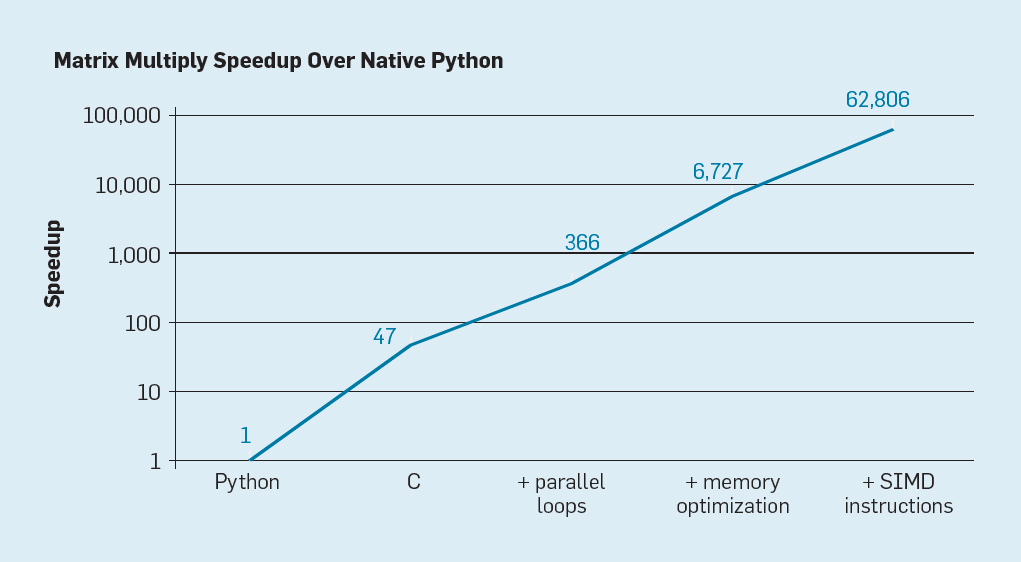Lecture 12: SIMD and Vectors
COSC 273: Parallel and Distributed Computing
Spring 2023
Announcements
- Homework 02: Now Due Next Friday (03/10)
- Lab 03 will be due after spring break
Outline
- Hardware and SIMD instructions
- Java
VectorAPI - Benchmarking Notes
Performance, Again

More Powerful Hardware
In Java, int and float values are 32 bits long
In modern CPUs, registers are larger
- standard 64 bit registers
- “vector” registers: 256 or 512 bits
Naive Operations
int a = 573842;
int b = 3847253;
int c = a + b;
SIMD Operations
int a1 = 573842;
int b1 = 3847253;
int c1 = a1 + b1;
int a2 = 38657548;
int b2 = 438573;
int c2 = a2 + b2;
Picture of SIMD Registers
Naive Loops
int[] a = new int[n];
int[] b = new int[n];
int[] c = new int[n];
for (int i = 0; i < n; i++) {
c[i] = a[i] + b[i];
}
Using Full Power
Suppose we can load step values into each register
int[] a = new int[n];
int[] b = new int[n];
int[] c = new int[n];
for (int i = 0; i < n; i += step) {
c[i] = a[i] + b[i];
c[i+1] = a[i+1] + b[i+1];
...
c[i+step-1] = a[i+step-1] + b[i+step-1]
}
Example from Lab 02
float min = Float.MAX_VALUE;
for (int k = 0; k < size; ++k) {
float x = matrix[i][k];
float y = matrix[k][j];
float z = x + y;
if (z < min) {
min = z;
}
}
shortcuts[i][j] = min;
Question. How could we (maybe) speed this up with SIMD parallelism?
SIMD Speed-up?
Java Vector API
Allows us to specify Vector objects
-
Vectoris like fixed-size array- elements are lanes
- tune
Vector(bit) size to same as hardware registers - perform elementary operations on entire vectors
Notes:
-
VectorAPI in Java 19, available as “incubator” - Many optimizations already done (without
Vector)
Example
Find entry-wise maximum of arrays:
VectorSpecies<Float> SPECIES = FloatVector.SPECIES_PREFERRED;
...
public static float[] vectorMax(float[] a, float[] b) {
float[] c = new float[a.length];
int step = SPECIES.length();
int bound = SPECIES.loopBound(a.length);
...
}
Example Continued
Find entry-wise minimum of arrays:
...
int i = 0;
for (; i < bound; i += step) {
var va = FloatVector.fromArray(SPECIES, a, i);
var vb = FloatVector.fromArray(SPECIES, b, i);
var vc = va.max(vb);
vc.intoArray(c, i);
}
for (; i < a.length; i++) {
c[i] = Math.max(a[i], b[i]);
}
return c;
}
Speedup, Personal Computer
Hello, vectors!
The FloatVector has 8 lanes.
Computing max array with simple methods...
That took 625 ms.
Computing max array with vector methods...
That took 174 ms.
The arrays are equal!
Speedup, HPC Cluster
Hello, vectors!
The FloatVector has 8 lanes.
Computing max array with simple methods...
That took 518 ms.
Computing max array with vector methods...
That took 66 ms.
The arrays are equal!
Complications
Java Vector API is still an “incubator” feature
- not part of the “standard” language yet
- only available in Java 17+
- my code works for Java 19
Using Vector API
To use Vectors your computer you must:
- have newest Java installed
- run
javac --versionfrom command line to see compiler version - run
java --versionto see JRE version
- run
-
inlclude
Vectorpackage in program:import jdk.incubator.vector.*; -
compile and run telling Java you’re using incubator features:
> javac --add-modules jdk.incubator.vector [files to compile] > java --add-modules jdk.incubator.vector [program to run]
Using Vector API on HPC
Must load a module with correct version of Java:
> module load amh-java/19.0.1
> javac --add-modules jdk.incubator.vector [files to compile]
> java --add-modules jdk.incubator.vector [program to run]
Better still:
- use
sbatchas in homework assignments with all of these commands in the test script!
Benchmarking Notes
To give “accurate” measure of efficiency:
- test running time of method for many invocations
- run several invocations before starting timing
- “warm up” primes hardware with correct instructions
Min-Plus Example
Input
-
float[] a, sizen -
float[] b, sizen
Output
- minimum of
a[i] + b[i]fromi = 0ton - 1
Min-Plus Vanilla Implementation
float min = Float.MAX_VALUE;
for (int i = 0; i < a.length; i++) {
float x = a[i]; float y = b[i];
float z = x + y;
if (z < min) {
min = z;
}
}
return min;
Min-Plus Vector Implementation
int step = SPECIES.length();
int bound = SPECIES.loopBound(a.length);
var mv = FloatVector.broadcast(SPECIES, Float.MAX_VALUE);
int i = 0;
for (; i < bound; i += step) {
var va = FloatVector.fromArray(SPECIES, a, i);
var vb = FloatVector.fromArray(SPECIES, b, i);
mv = mv.min(va.add(vb));
}
float min = mv.reduceLanes(VectorOperators.MIN);
...
Min-Plus Vector Implementation (2)
Cleanup:
float min = mv.reduceLanes(VectorOperators.MIN);
for (; i < a.length; i++) {
float x = a[i];
float y = b[i];
float z = x + y;
if (z < min) {
min = z;
}
}
return min;
Performance
Vanilla vs Vector on HPC
The FloatVector has 8 lanes.
Computing min-plus with simple methods...
That took 654 ms.
Computing min-plus with vector methods...
That took 254 ms.
c = 0.0054750443
d = 0.0054750443
The values are equal!
PC Performance, Demo
Lab 02b (Optional)
Add vector instructions to your shortcut program!
Next Time
- More Vectors!
- Lab 03